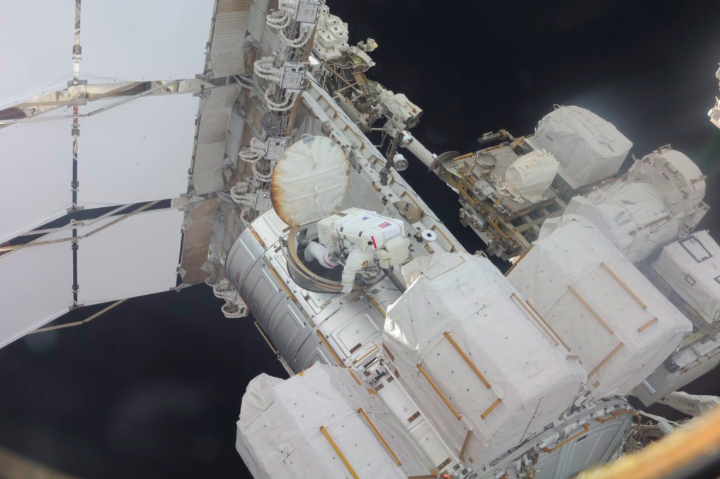
Fifteen years ago, this week, the crew of STS-104—Commander Steve Lindsey, Pilot Charlie Hobaugh, and Mission Specialists Mike Gernhardt, Janet Kavandi, and Jim Reilly—rocketed into the pre-dawn darkness to effect a major change to the fledgling International Space Station (ISS). Over the next 12 days, they worked to install and activate the Quest airlock, which would provide nothing less than a doorway to space; and a means, in NASA’s words, of enabling “a higher degree of station independence in its own construction and maintenance.” Before STS-104, all station-building spacewalks had been performed via the airlocks of resident shuttles. After STS-104, the option was available for EVAs to be performed directly from the station itself and, for the first time, could be executed without a shuttle being present.
As outlined in yesterday’s AmericaSpace history article, Quest—originally known as the “Joint Airlock” and intended to handle U.S. and Russian space suits—formed the last segment of Phase Two, the second of three phases which saw the International Partners (IPs) merge their human spaceflight programs. During Phase One, the United States and Russia had accomplished rendezvous and docking missions between the shuttle and the Mir space station and American astronauts had spent months working in orbit. Then, during Phase Two, the initial stones of the ISS were laid: its Unity connecting node, its Zarya (“Sunrise”) control module, its Zvezda (“Star”) service module, its first set of power-generating solar arrays, its U.S.-built Destiny laboratory, and its Canadian-made robotic arm. The final piece before the ISS progressed into its Phase Three of “full utilization” was to allow the station to be assembled, repaired, and maintained from within: by installing Quest.
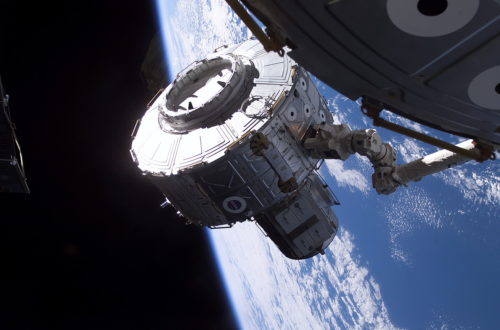
On 14 July 2001, two days after rising into the darkened skies of Cape Canaveral, Shuttle Atlantis had brought Quest to the station and through a complex ballet of robotic and spacewalking operations the new airlock had been installed onto the starboard side of the Unity node. Two EVAs by Gernhardt and Reilly had connected power and data cables and three of four high-pressure oxygen and nitrogen tanks had been fitted. The final EVA, on the night of 20/21 July, would see the spacewalkers prepare and depart the station via Quest for the first time. In anticipation of this momentous event, the hatch separating the airlock’s inner “equipment lock” and the outer “crew lock” had been installed and Quest had been declared ready to support its first spacewalk.
Clad in their white Extravehicular Mobility Unit (EMU) space suits, Gernhardt and Reilly departed the airlock at 12:35 a.m. EDT on 21 July to install a high-pressure nitrogen tank onto Quest’s external hull and tend to other tasks. Three other tanks—two of oxygen, one of nitrogen—had been installed a few days earlier and would serve to replenish the atmosphere of the station’s U.S. Orbital Segment (USOS). After donning their suits in the broader equipment lock, Gernhardt and Reilly and their tools were bundled into the narrow crew lock and the hatch was closed behind them. Depressurization of the crew lock took 40 minutes, longer than anticipated, but the astronauts set to work on their respective tasks. By the time they returned to Quest, they had been outside for four hours and two minutes. Thus concluded the first of what currently stands at 116 Quest-based EVAs.
Atlantis and her crew returned to Earth several days later, leaving the station’s incumbent Expedition 2 crew of Commander Yuri Usachev and Flight Engineers Jim Voss and Susan Helms to continue outfitting the new airlock. Two subsequent missions—STS-105 in August 2001 and STS-108 in December 2001—would both utilize their own shuttle airlocks for EVAs. “When it came down to the time that we had to finalize our EVA timelines, it was not clear whether we would be flying first or [STS-104] would be flying first,” recalled STS-105 spacewalker Dan Barry in a NASA interview. “So since we couldn’t be really certain that the airlock would be there, even, and available for use, we had to make the decision to come out of the shuttle airlock.” This did pose an impact to the STS-105 and STS-108 timelines, in that the hatches between the two space vehicles had to be closed, in order that the shuttle’s cabin pressure could be lowered from 14.7 psi to 10.2 psi for EVA operations. “That kind of impact to our timeline we had to determine early on,” added Barry. “If we waited until today, effectively, to determine that we did have the Joint Airlock available, it’s really too late to make the final planning changes to our flight plan and to our EVAs.”
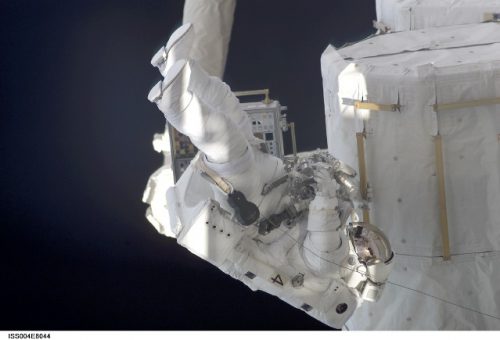
As a result, it was not until 20 February 2002 that Quest was again employed to see off a pair of spacewalkers from its crew lock. On that day, which coincidentally marked the 40th anniversary of John Glenn’s Earth-orbital flight, Expedition 4 astronauts Carl Walz and Dan Bursch ventured outside for almost six hours to prepare the station for the arrival of its S-0 truss segment. The latter would provide a mounting location for the space station’s truss structure and network of solar arrays, radiators, and batteries. Significantly, though, Walz and Bursch’s Quest-based spacewalk was the first to be performed in U.S.-built suits and undertaken without the shuttle being present. As such, it was designated “U.S. EVA-1,” the first in a long line of “Stage EVAs” which—at the time of writing—have seen no less than 35 spacewalks performed by incumbent station residents.
Those Stage EVAs were relatively few and far between in the early days. Following Walz and Bursch’s spacewalk, U.S. EVA-2 took place on 15 January 2003 and saw Expedition 6 astronauts Ken Bowersox and Don Pettit continue with the outfitting of the station’s new P-1 truss segment. Although theirs was only the second Stage EVA, four previous shuttle crews had already utilized Quest for 13 spacewalks during the course of 2002. These spacewalks had installed S-0, the Mobile Transporter (MT) and Mobile Base System (MBS) for the Canadarm2 robotic arm and the S-1 and P-1 trusses. During one of those missions, STS-111 in June 2002, Frenchman Philippe Perrin had become the first non-U.S. spacefarer to perform an EVA from Quest.
After Bowersox and Pettit’s EVA, a period of three months elapsed before they ventured outside again on U.S. EVA-3. And during the course of those months, NASA and the space station had changed beyond recognition. The loss of Columbia and her seven astronauts during re-entry would ground the shuttle fleet for more than two years and ISS operations were correspondingly scaled back with two-man “caretaker” crews. When Bowersox and Pettit returned inside the station in April 2003, it would be 31 months before another pair of spacewalkers departed Quest. In November 2005, Expedition 12 crewmen Valeri Tokarev—the first Russian cosmonaut to perform an EVA from Quest—and Bill McArthur spent 5.5 hours tending to a range of external maintenance tasks. Their work prepared the airlock for a new lease of life as shuttle operations resumed and construction of the ISS expanded.
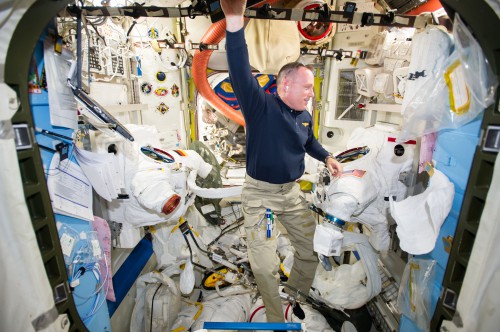
On 3 April 2006, McArthur and newly-arrived Expedition 13 astronaut Jeff Williams trialed a new procedure known as a “Campout Pre-Breathe,” which it was hoped could shorten the length of time required to prepare for future Quest-based EVAs. In essence, the duo packed their sleeping bags and spent the night inside the airlock. Future spacewalkers would follow this protocol in order to shorten the time needed to breathe pure oxygen to avoid decompression sickness from hours to a matter of minutes. McArthur and Williams lowered the air pressure inside Quest from 14.7 psi to 10.2 psi and camped out overnight, allowing the lower pressure to flush nitrogen faster from their bloodstreams. The down side, though, according to NASA, was having to “rough it” with a cold supper and no bathroom for the night. …
Over the next few years, the Campout Pre-Breathe and its subsequent evolution would be used for Stage EVAs and spacewalks conducted by shuttle astronauts out of Quest. During STS-115 in September 2006, spacewalkers Joe Tanner, Heidemarie Stefanyshyn-Piper, Dan Burbank, and Canada’s Steve MacLean, working in two alternating pairs, evaluated the procedure during their three EVAs. By years’ end, Quest had therefore seen not only its first Canadian occupant, but also its first German (Thomas Reiter) and its first Swede (Christer Fuglesang), which raised the status of the airlock from being a U.S.-built module to an integral component of an international partnership.
Nor would the raft of records end there. Stefanyshyn-Piper became the first female astronaut to use Quest and subsequent EVAs would see spacewalkers depart the airlock to install truss segments, the Harmony and Tranquility nodes and the European Columbus and Japanese Kibo laboratories, as well as tending to the ongoing necessity for station maintenance and repair. In September 2012, Expedition 32 spacewalkers Sunita Williams and Akihiko Hoshide performed the 100th Quest-based EVA. In doing so, Williams became the new record-holder for the greatest amount of spacewalking time accrued by a woman and Hoshide became the first Japanese occupant of Quest. A year later, in July 2013, Italy’s first spacewalker Luca Parmitano became—by default—the first Italian citizen to make an EVA from Quest and in January 2016 Tim Peake did likewise for the United Kingdom.
Pre-EVA protocols have changed over the years. In May 2011, the STS-134 astronauts pioneered In-Suit Light Exercise (ISLE) as an improved means of removing nitrogen from the bloodstream. This practice moved from pre-breathing on masks, during which time the equipment lock was depressed from 14.7 psi to 10.2 psi, to a nominal pre-breathing regimen, combined with several 50-minute spells of light exercise.
As of today, 116 spacewalks have been performed from Quest over the last 15 years, with the next EVA currently scheduled for the third week in August 2016 by Expedition 48 Commander Jeff Williams and newly-arrived Flight Engineer Kate Rubins. Their task will be to install and activate the first International Docking Adapter (IDA) at the forward “end” of the Harmony node. And for Williams, it will bring his spacewalking career full-circle, for he initially trialed the Campout Pre-Breathe, way back in April 2006, then evaluated it for real during his Quest-based EVA with Germany’s Thomas Reiter the following summer.
This is part of a series of history articles, which will appear each weekend, barring any major news stories. Next week’s article will focus on the 50th anniversary of Gemini X.
Want to keep up-to-date with all things space? Be sure to “Like” AmericaSpace on Facebook and follow us on Twitter: @AmericaSpace




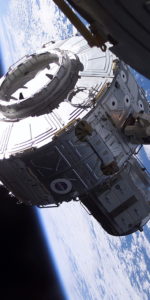

One Comment
One Ping
Pingback:‘Easier to Destroy Than Create’: 15 Years Since STS-105 (Part 2) « AmericaSpace